- « Return to page
- Home
- Our School
- Headteacher's Welcome and Prospectus
- Vision and Values
- Our Team
- Admissions - Applying for a place
- Our Governors
- Safeguarding
- Pastoral Support Hub
- Policies
- Key Information
- Key Information
- Assessment and school performance
- Music Development Plan Summary
- Pupil Premium and Inclusion
- SEND - Special Educational Needs and Disabilities
- School Improvement
- Academy Business, Finance and Legal
- PE and Sports Premium Funding
- Complaints
- Equality at Newcroft
- Ofsted Report
- Parent Survey
- School Opening Hours
- Pupil Survey
- Vacancies
- Privacy & Cookies
- Our Forest School
- Teacher Training
- Preschool
- For Parents
- Attendance
- SEND- Special Educational Needs and Disabilities
- SEND Parental Information and Support
- Pastoral and Mental Health and Wellbeing Support
- Success for all Phonics - Support for Parents
- School Dinners
- Term Dates
- Reading Advice for Parents
- Breakfast and After School Club
- Keeping safe online
- Extra Curricular Clubs
- Uniform
- Friends of Newcroft
- Our Forest School
- Remote Learning
- WEDUC Communication
- Curriculum
- Classes
- News
- Contact
- Home
- Our School
- Headteacher's Welcome and Prospectus
- Vision and Values
- Our Team
- Admissions - Applying for a place
- Our Governors
- Safeguarding
- Pastoral Support Hub
- Policies
- Key Information
- Assessment and school performance
- Music Development Plan Summary
- Pupil Premium and Inclusion
- SEND - Special Educational Needs and Disabilities
- School Improvement
- Academy Business, Finance and Legal
- PE and Sports Premium Funding
- Complaints
- Equality at Newcroft
- Ofsted Report
- Parent Survey
- School Opening Hours
- Pupil Survey
- Vacancies
- Privacy & Cookies
- Our Forest School
- Teacher Training
- Preschool
- For Parents
- Attendance
- SEND- Special Educational Needs and Disabilities
- SEND Parental Information and Support
- Pastoral and Mental Health and Wellbeing Support
- Success for all Phonics - Support for Parents
- School Dinners
- Term Dates
- Reading Advice for Parents
- Breakfast and After School Club
- Keeping safe online
- Extra Curricular Clubs
- Uniform
- Friends of Newcroft
- Our Forest School
- Remote Learning
- WEDUC Communication
- Curriculum
- Classes
- News
- Contact
Aspiring for Excellence
in all we do
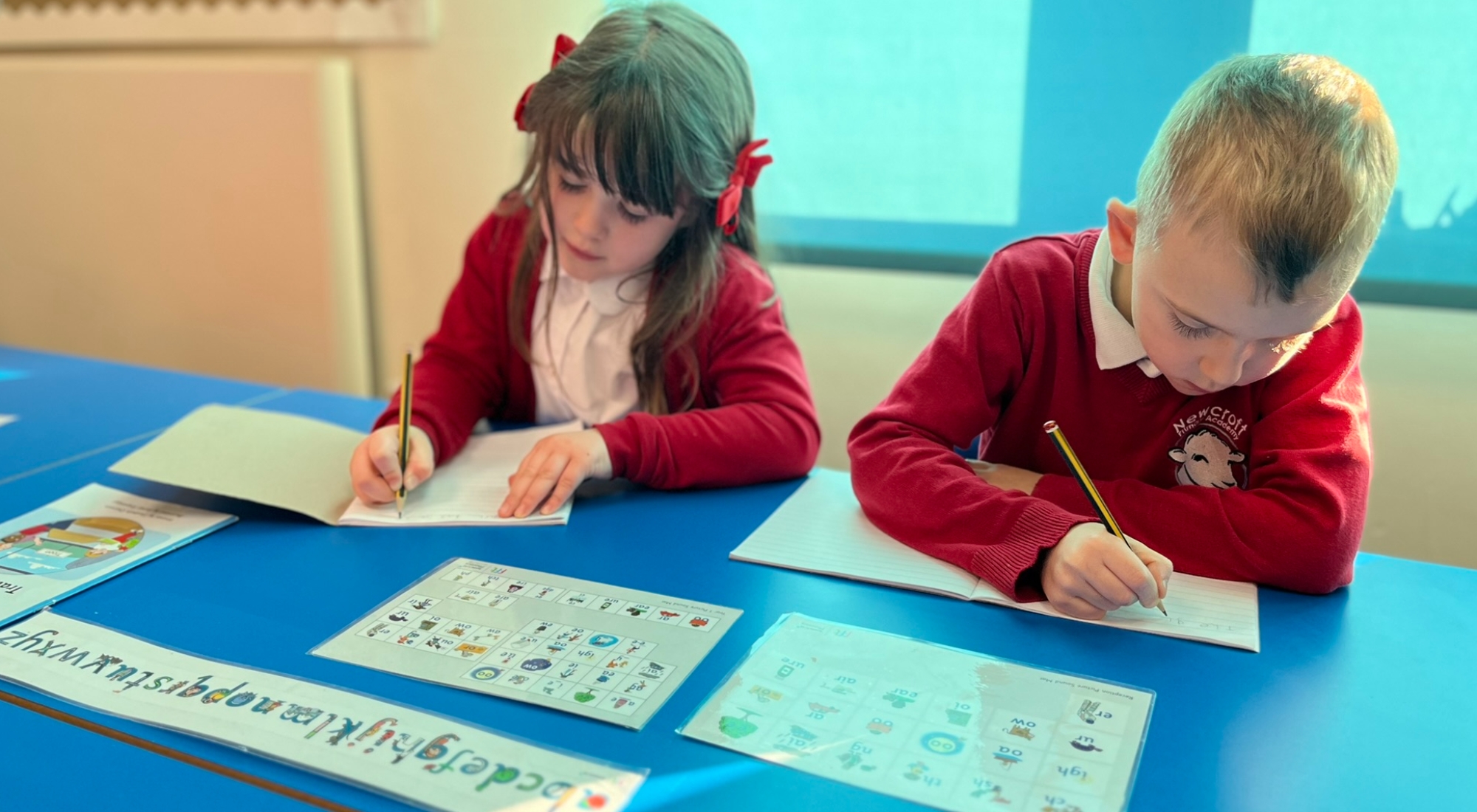
Search

Our Autumn 1 2025 newsletter is out!
Welcome to our first newsletter of the 2025-26 academic year! ...
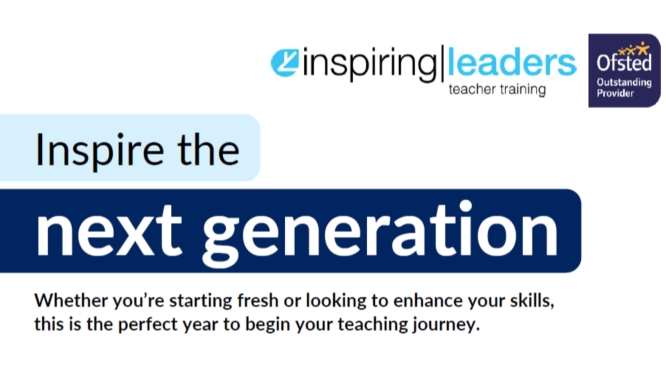
Train to teach at Newcroft
Are you interested in training to become a teacher? Find out more about our prog...
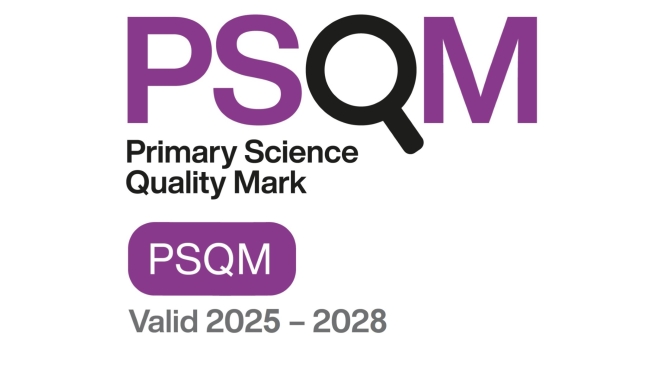
Newcroft Achieves the Primary Science Quality Mark!
Congratulations to Miss Lloyd and all our teaching and support staff and pupils ...

Our Autumn 2 Clubs timetable is live!
Our Autumn 2 Clubs timetable is out! Find out more here. ...
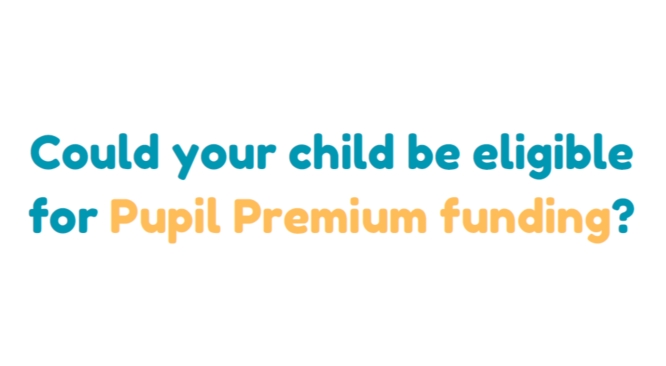
Pupil Premium main school and pre school- are you eligible?
Find out if your child is eligible for pupil premium funding for our main school...

Our Forest School is open!
We are thrilled to announce our very own Forest School is open on site from Augu...

Newcroft Achieves Top Scores in 2024-25!
We are pleased to share our exceptional pupil results across all areas of statut...

Our 'outstanding' promotional video is out!
Click to view our 'Outstanding' promotional video. We hope you enjoy it! ...

Newcroft has been rated as 'Outstanding in all areas' by Ofsted- May 2025'
We are thrilled to announce that we have been rated as 'outstanding in all areas...
Early Reading and Phonics
Success For All Phonics
We use a DfE validated scheme called ‘Success for All’ from the Fischer Family Trust (FFT). This scheme has been validated by the Department for Education. We are thrilled to be a Success for All Partner School, a testament to our commitment to academic excellence and pupil success. Through this partnership, we have implemented effective strategies to improve early reading skills, ensuring that every child has a strong foundation for future achievements on our journey towards creating a community of lifelong learners!
.png)
To find out more about our scheme, click here.
Reading
At Newcroft, we teach reading explicitly and implicitly, as part of our daily English lessons. This includes reading domain lessons, VRIC sessions (Years 2-6), daily phonics lessons, group reading, interventions, 1:1 reading with teachers, support staff and volunteers.
Our pupils are also taught the skills of reading and are immersed in literature through the foundation curriculum.
In Reception and Year 1 children have a daily phonics and reading lesson using the DfE validated scheme called ‘Success for All’ from the Fischer Family Trust (FFT). Throughout the week, children work on a range of skills to develop and practise their phonological awareness and reading skills to support them in becoming successful independent and fluent readers.
Books at Newcroft
Books at Newcroft for Reception and Year 1
We use a range of phonics books to support children in learning sounds and developing comprehension. Children in Reception and Year 1 (and any other children still accessing phonics lessons) have a Success For All (SFA) shared reader book aligned to the GPCs they are currently learning in their daily phonics and reading lessons. The SFA books are also available electronically on the parent portal or via the QR code supplied by their phonics teacher. Vimeo links are also sent home to enable their current book to enable the read aloud facility on an electronic device to support reading at home.
In addition to this, they have a white stickered book with a numbered step number on, which is closely matched to what they have learnt in their phonics lessons. These books are fully decodable and only contain GPCs and red words that the children have been taught in class, to enable them to practise their reading and build their confidence and fluency.
These reading books are used daily in school, so it is vital that your child brings their phonics book to school daily in the wallet provided.
Books at Newcroft for Years 2- 6
In years 2 to 6, children read a colour banded which follows the National Book Banding system, which we adopt at Newcroft. Children select books according to the colour band they are working on, depending on their reading and comprehension level, which are reviewed regularly by the class teacher. Children bring these books home to read as well as reading at least once a week in school with an adult.
Reading for Pleasure
Children in all year groups are encouraged to take home a reading for pleasure book either from their class reading area or the school library. For younger children, these books are for you to read and enjoy with your child.
Phonics Progression
The scope and sequence on the chart below is a guide to what your child will be learning at each phase and Term at Newcroft. Progression is built in throughout the programme with an increase in the level of challenge in the skills taught at each phase:
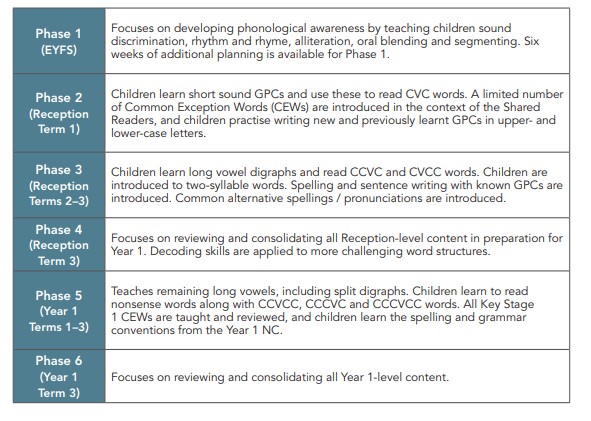
All staff teaching phonics have undergone extensive training in order to be able to deliver this new scheme. They all have detailed planning that is divided into weeks or ‘steps’ that cover the Grapheme, Phoneme, Correspondence (GPC’s) for both phonics and reading.
To support both teachers and children, the phonics lessons follow a consistent daily structure with clear timing goals for each activity. This consistent approach enables lessons to be taught with pace as everybody understands the routine and what is expected. Each lesson lasts 25 minutes and follows the same basic sequence each day:
• Review of Previously Taught GPCs (10 minutes)
• Teach, Practise and Apply New GPC (15 minutes).
Phonics Vocabulary
From the very first moment your child starts learning phonics at Newcroft, they are introduced to the vocabulary detailed on the chart below:
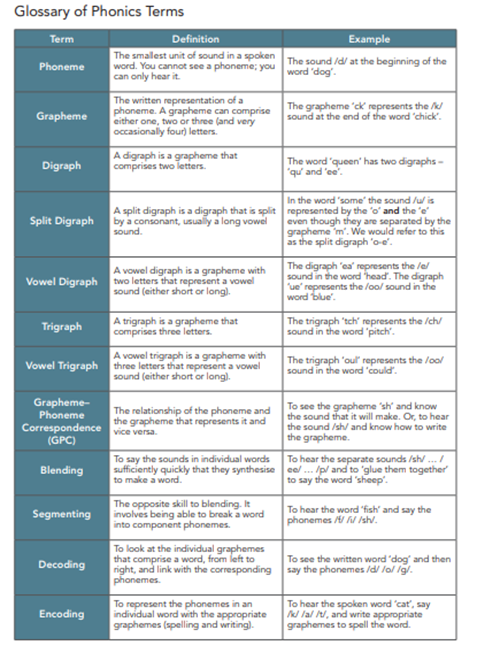
Phonics advice for parents
- Read for short bursts frequently with your child (at least 3 times per week)
- Keep re-reading the same book over and over again to gain confidence and improve fluency
- Use the Vimeo links so your child can listen to their SFA book being read aloud to them
- Practise ‘stretching and reading’ (decoding and blending) the green words on the inside cover of the SFA book
- Practise ‘say, spell, saying’ the red words
- Look on the parent portal for advice and videos to support you
- Use the flashcards and other resources that have been sent home to you
- Practise letter formation in a variety of ways, such as: forming it with a finger in the air, on the palm of the hand, on the back of someone, on the floor, in paint, glitter or sand. Try these before writing on a whiteboard or paper.
Alien/Pseudo/Monster Words
When your child begins to become confident in segmenting and blending activities in Year 1, they will be introduced to alien words in their phonics lessons. This is because in Year 1 all children take a Phonics Screen Check in June, which requires the children to read real and alien words. Alien words are not real words and they will only learn to decode and read these words.
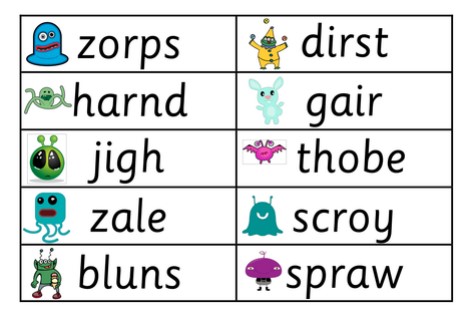
The phonics screening check is designed to confirm whether individual children have learnt phonic decoding and blending skills to an appropriate standard. Alien words are included because they will be new to all pupils; they do not favour children with a good vocabulary knowledge or visual memory of words. This tests whether children know their sounds and can use them to decode new unfamiliar words. Below are some examples of alien words. If you would like more information about the Year 1 Phonics Screen Check please visit:
DfE information about the Year 1 Phonics Screen Check
Common Exception Words
Children in Year 1 and 2 need to learn to read and spell the common exception words below. They will be taught these in daily phonics lessons and will be given opportunities in other learning activities to learn these. These will be the words your child will bring home to learn each week to practise. They need to practise reading and spelling them, as well as apply them in their written work.
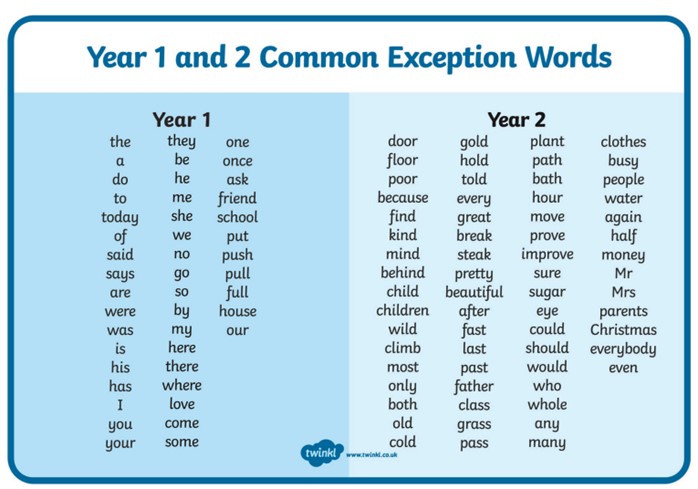
Further Help for Parents
There is a Parent Portal (access details can be found on the inside cover of your child’s Home/school diary), where you will find all the resources to help you support your child’s phonics and early reading. There are helpful videos modeling correct pronunciation for the phonemes.
The materials are designed to support the learning your child is experiencing in school. At the moment, the resources include all of the Shared Readers so you can reread and enjoy the books together after they have been read in school.
This portal is updated frequently, so keep checking to see what’s new on there! There are lots of tips on there in how to support your child with their reading and phonic development.
Websites offering a range of phonics games to make learning at home fun!
https://www.phonicsplay.co.uk/
https://www.topmarks.co.uk/english-games/3-5-years/letters-and-sounds
https://www.bbc.co.uk/cbeebies/grownups/the-alphablocks-guide-to-phonics
Lead contact: Mrs Amy Bingham, Business Manager
Newcroft Primary Academy
Trueway Drive
Shepshed
Leicestershire
LE12 9DU
01509 503214
[email protected]
Home / Privacy Policy & Cookies / Site map / Admin
© 2018 - 2025 Newcroft Primary Academy. All rights reserved.

